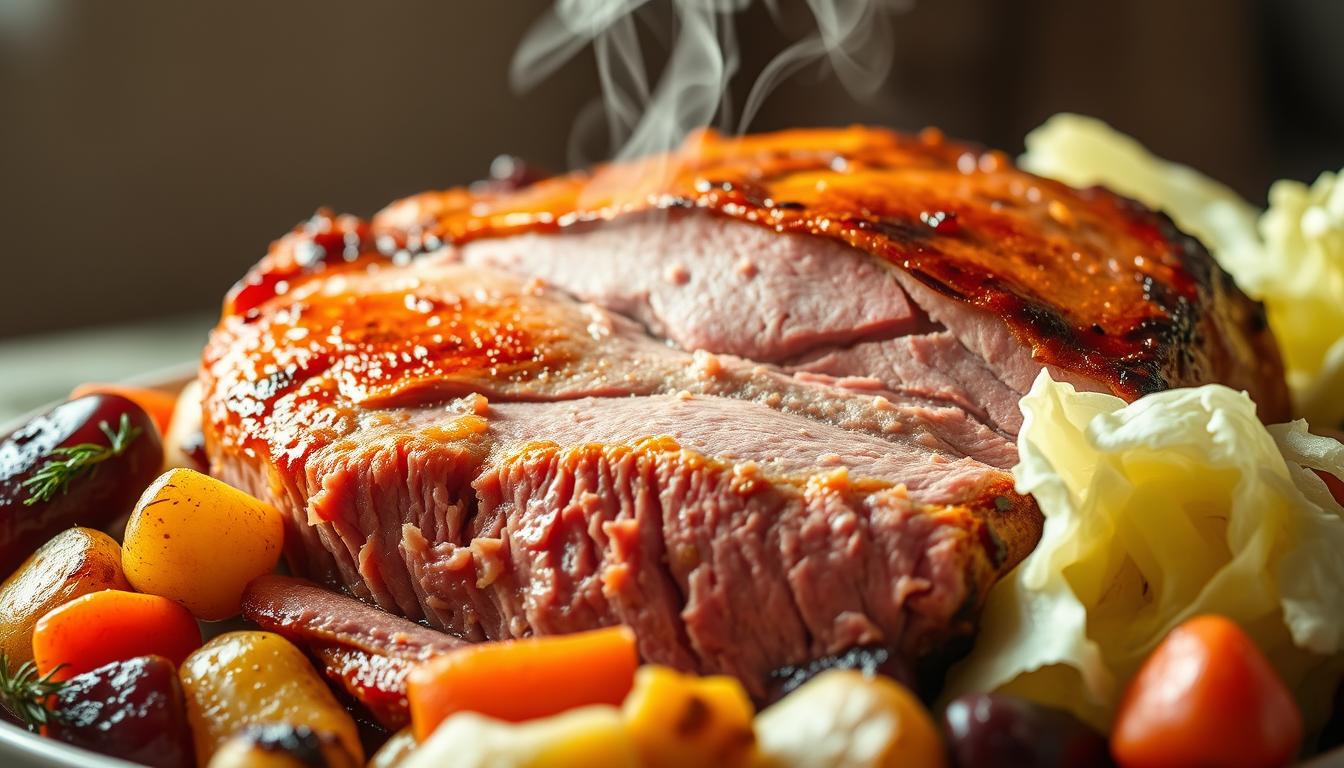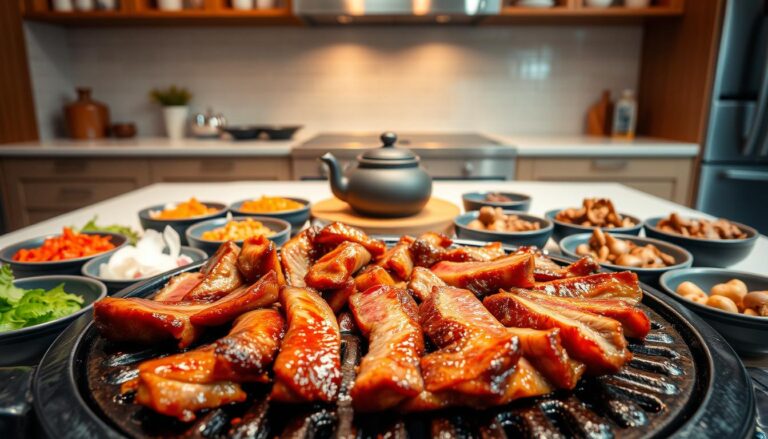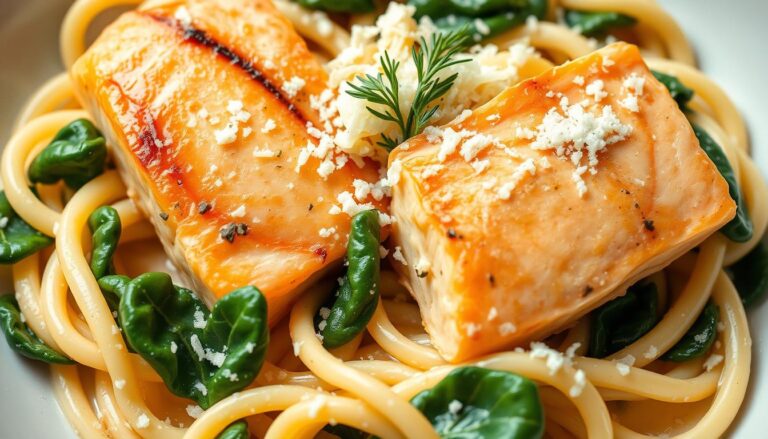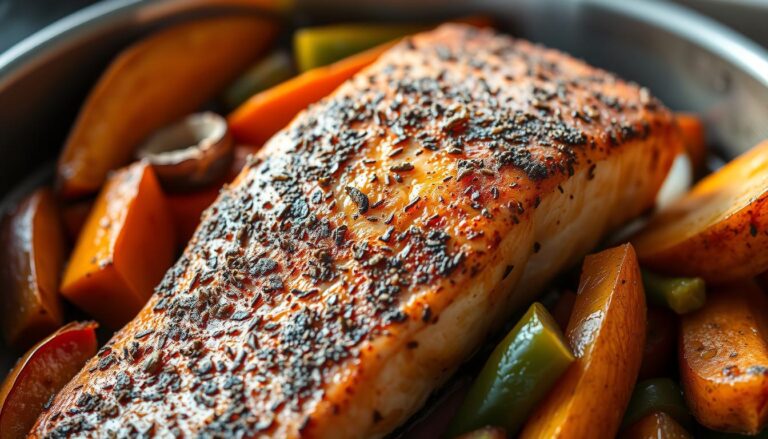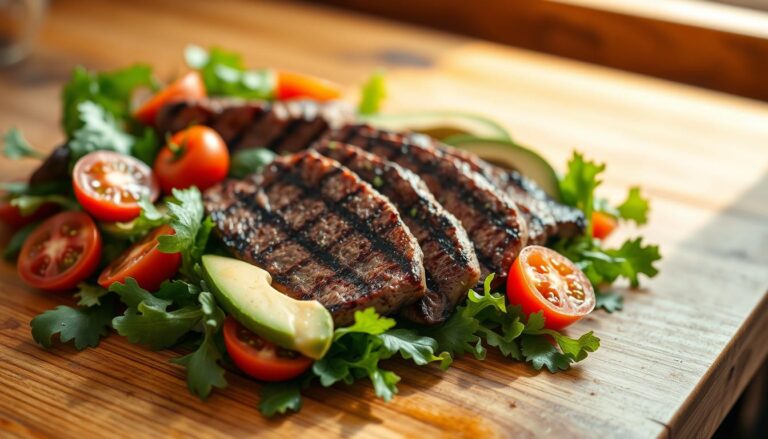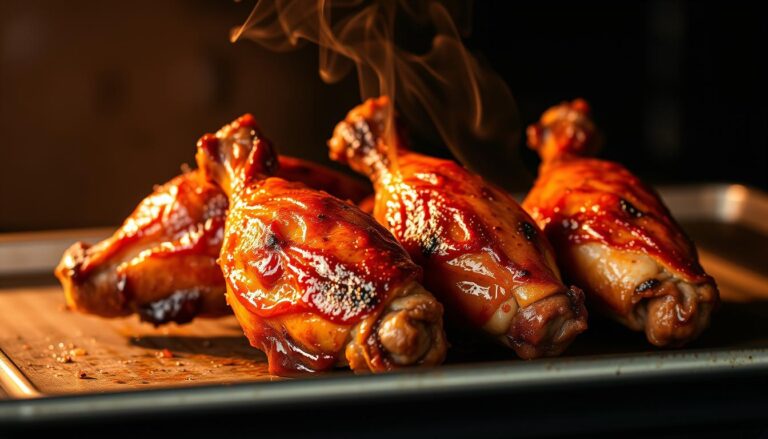How to Make the Best Corned Beef – Tender, Juicy, and Flavorful!
Growing up, St. Patrick’s Day was a big deal in my family. We always had a big meal together. Making the perfect corned beef was a big part of that tradition.
Corned beef is more than just a meal. It’s a journey that needs patience, skill, and a love for old cooking ways. From picking the right brisket to slow-cooking it, every step is important. It makes a dish that everyone will love.
Whether you’re experienced in the kitchen or just starting, this guide will help you. You’ll learn to make corned beef that’s tender, full of flavor, and a favorite in your home.
Table of Contents
Understanding Corned Beef: History and Tradition
Corned beef has a rich history that spans continents and generations. It’s a dish that tells a story of Irish-American cuisine, migration, and culinary adaptation. It shows how food can become a symbol of identity and survival.
Origins of Irish-American Cuisine
The history of corned beef in Irish-American culture is deep. In the mid-19th century, Irish immigrants came to the United States. They found a new world of food, where beef was more common than pork.
- Irish immigrants found beef more affordable in New York
- Kosher butcher shops became primary sources of meat
- Cultural exchange shaped new food traditions
Why It’s Called “Corned” Beef
The term “corned” might sound odd, but it means the coarse salt grains used to cure the meat. These salt “corns” helped preserve beef before refrigeration. In the 17th century, Cork, Ireland, was a big center for corned beef production, exporting half of Ireland’s beef.
Traditional St. Patrick’s Day Connection
St. Patrick’s Day made corned beef a cultural icon. It started as an immigrant adaptation but became a beloved tradition. It wasn’t a staple in Ireland but became a celebrated meal among Irish-Americans, symbolizing resilience and community.
Today, corned beef is still a cherished part of Irish cuisine, celebrated on St. Patrick’s Day in the United States.
Essential Ingredients for Perfect Corned Beef
Making the perfect corned beef starts with picking the right ingredients. Curing meat needs precision and quality parts to turn a simple brisket into a tasty treat. Knowing each ingredient’s part in the brining process is key to great corned beef.
For a classic homemade corned beef, you’ll need these main ingredients:
- Beef Brisket: A 5-pound cut is best for home cooking
- Kosher Salt: About 300 grams (2 cups)
- Brown Sugar: ½ cup for a balanced taste
- Pink Curing Salt: Around 5 teaspoons
- Pickling Spice Blend: Up to 9 different spices
The brining process takes 5 to 7 days. This lets the salt and spices soak into the meat. A basic brine recipe uses 1 gallon of water and includes important spices like:
- Allspice berries
- Mustard seeds
- Coriander seeds
- Black peppercorns
- Minced garlic
When curing meat, pink curing salt is used. It has sodium nitrite to keep the beef’s color and stop bacteria. But use it carefully, as it’s harmful in large amounts.
Pro tip: Use a 2-gallon freezer bag for easy brining. Only half the brine is needed for a standard 5-pound brisket.
Choosing the Right Cut of Brisket
Choosing the perfect brisket is key to making delicious corned beef. Brisket has two main cuts that affect flavor and texture. Knowing these differences helps you pick the best for your dish.
Flat Cut vs Point Cut: Understanding the Differences
Brisket comes in two types, each with its own traits:
- Flat Cut: Leaner and more uniform in shape
- Point Cut: More marbled with fat, offering richer flavor
| Cut Type | Fat Content | Flavor Profile | Best Used For |
|---|---|---|---|
| Flat Cut | Lean | Mild | Neat slicing, presentation |
| Point Cut | High | Rich, intense | Maximum flavor, tender texture |
Quality Considerations When Buying Brisket
When buying brisket, look for these signs:
- Meat should feel firm, not soft or mushy
- Look for consistent marbling throughout
- Choose bright, fresh-looking meat
- Check for minimal excess liquid in packaging
Size and Weight Recommendations
Think about how many people you’re serving when picking brisket. A 3-pound brisket is good for 8 people. For bigger groups, get more to make sure everyone gets a tasty piece.
Brining and Seasoning Techniques
Brining turns a regular brisket into a tasty corned beef dish. This method uses a flavorful salt solution to soak into the meat. This makes it tender and juicy.
Creating the right brine is all about precision and the right ingredients. Here’s what you need for a great brine:
- Kosher salt for base seasoning
- Pink curing salt #1 for color preservation
- Brown sugar for balanced flavor
- Whole spices like peppercorns, juniper berries, and bay leaves
Here are key steps for brining corned beef:
- Use 1 teaspoon of pink curing salt per 5 pounds of meat
- Brine for 5-7 days in a non-reactive container
- Ensure meat is completely submerged
- Rotate meat every 2-3 days for even flavor distribution
Pro tip: A gallon of brining liquid is perfect for a 5-7 pound brisket. The goal is to mix salt, sugar, and spices well. This will give your meat amazing flavor.
Preparing Your Corned Beef for Cooking
Getting your brisket ready is key for a tasty corned beef dish. The right prep turns a simple cut into a meal that wows everyone.
Trimming and Cleaning Your Brisket
Trimming your corned beef is crucial. Here’s how to do it right:
- Remove excess fat, leaving about 1/4 inch for flavor
- Rinse the brisket under cold water
- Pat it dry with paper towels
- Check for any tough skin or membranes
Adding Flavor with Garlic and Spices
Boost your corned beef’s flavor with these tips:
- Make small cuts on the brisket
- Put garlic slivers in the cuts
- Add whole spices like black peppercorns
- Use 2 tablespoons each of black peppercorns, yellow mustard seeds, and coriander seeds
Pre-Cooking Tips for Perfect Results
Get the best results with these expert tips:
- Let the brisket rest at room temperature for 30 minutes
- Cook at 325°F for tender meat
- Cook for about 3 hours
- Check for tenderness after 3 hours
By following these steps, you’ll make a corned beef dish that’s a hit with your family.
Beer-Braising Method for Tender Results
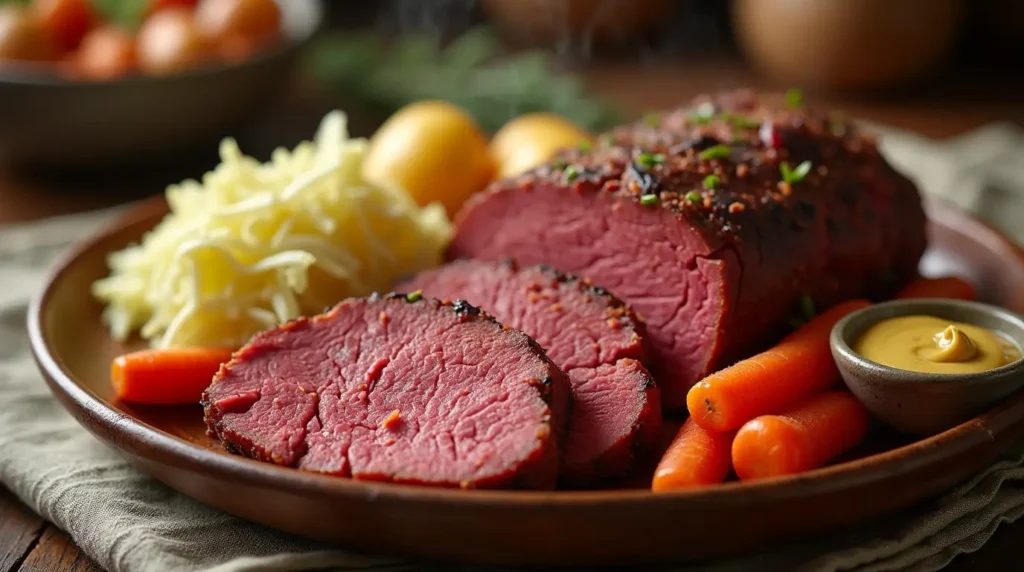
Beer braising is the secret to tender corned beef. It turns ordinary meat into a delicious treat that will wow anyone. This method is a game-changer for food lovers.
Beer braising tenderizes corned beef with its acids and tannins. It makes the meat soft and adds deep, rich flavors. These flavors make the dish even better.
Choosing the Right Beer
Not all beers are good for braising corned beef. Here are some top picks:
- Stout: Provides deep, robust flavors
- Lager: Offers a lighter, more balanced taste
- Amber Ale: Adds subtle caramel notes
Beer Braising Technique
For the best beer-braised corned beef, follow these steps:
- Use 2 pints of beer for braising
- Add 1 cup of water to the braising liquid
- Maintain an oven temperature of 300 degrees F
- Cook for approximately 3 hours
Pro tip: Make a tasty glaze with dark brown sugar, whole grain Dijon mustard, and Irish whiskey. It makes your corned beef shiny and full of flavor. Everyone will want more.
Cooking Times and Temperature Guidelines
Mastering the perfect corned beef needs precision in cooking times and temperatures. Knowing these guidelines will help you make a tender, flavorful dish. It will impress your family and friends.
Oven Temperature Settings
Temperature control is key when cooking corned beef. Here are the recommended oven settings:
- Standard baking temperature: 350°F
- Cooking time: 45-60 minutes per pound
- Water depth in roasting pan: 1/2 inch
Determining Doneness
Checking the internal temperature of your corned beef ensures perfect results every time. Use these target temperatures as your guide:
| Texture Goal | Internal Temperature | Cooking Characteristics |
|---|---|---|
| Firm Slices | 180°F | Solid, easy-to-slice texture |
| Super Tender | 195°F | Flaky, fall-apart meat |
For the most tender corned beef, cover your baking dish to prevent moisture loss. Pro tip: Let the meat rest for 10-15 minutes after cooking. This allows juices to redistribute.
Cooking Time Calculation
A simple rule of thumb for corned beef is to calculate approximately 50 minutes of cooking time per pound. For example:
- 2-pound brisket: About 1.5 hours
- 4-pound brisket: Roughly 3 hours
- 6-pound brisket: Around 4.5 hours
Remember to always use a meat thermometer. This ensures your corned beef reaches the desired internal temperature for the best results.
Traditional Side Dishes and Accompaniments
No corned beef meal is complete without the right side dishes. The classic combo of corned beef and cabbage is a big hit, perfect for St. Patrick’s Day.
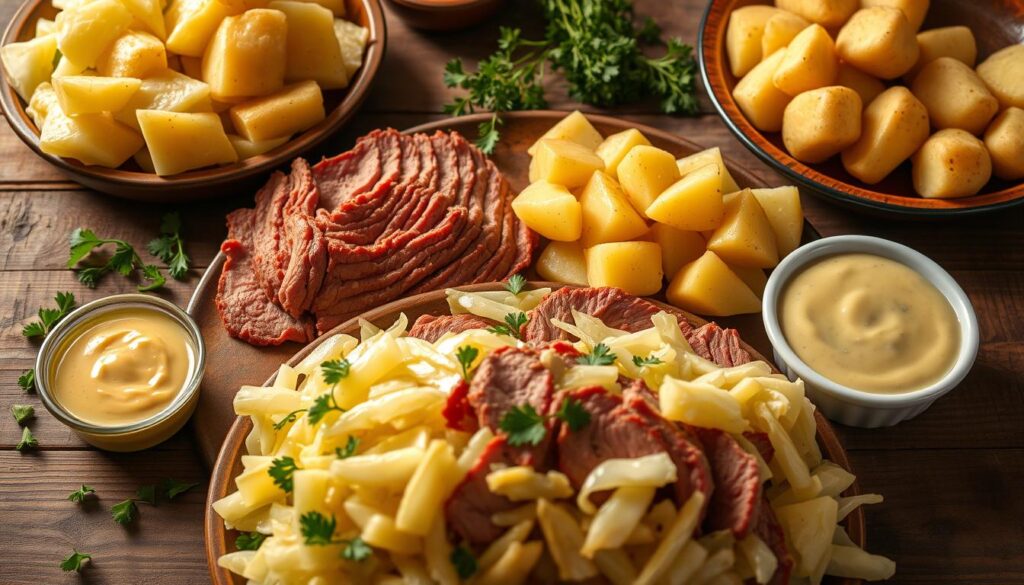
When you’re cooking up your corned beef feast, think about these traditional sides. They add flavor and cultural touch to your meal:
- Roasted cabbage wedges with crispy edges
- Garlic herb skillet potatoes
- Butter-glazed carrots
- Creamy mashed potatoes
- Irish soda bread
Cabbage is key in making corned beef taste even better. You can cook it in many ways:
- Boiled traditional style
- Roasted with olive oil and herbs
- Sautéed with bacon
- Beer-braised for deeper flavor
Here’s a quick guide for making classic side dishes:
| Side Dish | Preparation Time | Flavor Profile |
|---|---|---|
| Roasted Cabbage | 20 minutes | Sweet, crispy edges |
| Garlic Herb Potatoes | 30 minutes | Rich, savory |
| Buttered Carrots | 15 minutes | Sweet, tender |
Choosing and preparing side dishes thoughtfully turns your corned beef into a special meal. It’s a mix of tradition and modern taste that everyone will love.
Slicing and Serving Your Corned Beef
Learning to slice corned beef right can turn a simple meal into a feast. How you cut and serve your meat affects its tenderness and taste. This is crucial when making a tasty corned beef sandwich.
To get perfectly sliced corned beef, you need to know about its muscle structure. Always slice against the grain for the best tenderness. This method helps break down tough fibers, making each bite better.
Cutting Techniques for Ultimate Tenderness
- Use a sharp knife with a long, thin blade
- Identify the grain direction by looking at the meat’s muscle lines
- Cut perpendicular to these muscle fibers
- Aim for slices approximately 1/8 inch (0.32 cm) thick
Presentation Tips for Your Corned Beef
When serving corned beef, the thickness is key. For sandwiches, slice the meat almost as thin as paper, about 1/16 inch. For a platter, ½-inch thick slices are best, showing off the meat’s texture.
Pro tip: Let your corned beef rest for 10-15 minutes after cooking. This lets juices spread, making it up to 25% more moist. Cover it with aluminum foil to keep it warm and juicy.
Serving Suggestions
- Create classic Reuben sandwiches with 3-4 ounces of corned beef
- Serve 4-6 ounces per person for traditional meals
- Use leftovers for corned beef hash
By using these slicing and serving tips, you’ll make your corned beef truly special. It will ensure a great dining experience every time.
Storage and Leftover Ideas
Don’t let your delicious corned beef go to waste! You can turn leftovers into exciting new meals. This will keep your family excited about eating.
Storing corned beef properly is key. Wrap leftover meat tightly in aluminum foil or use an airtight container. Refrigerated corned beef stays fresh for 3-4 days. Frozen meat can last up to 3 months.
Delicious Leftover Recipes
- Classic Reuben sandwich with Swiss cheese and sauerkraut
- Corned beef hash topped with fried eggs
- Quesadillas featuring shredded corned beef
- Hearty corned beef pizza
- Individual quiches with corned beef
The Reuben sandwich is a crowd favorite for leftover corned beef. It has tangy sauerkraut, melted Swiss cheese, and Russian dressing on toasted rye bread. It turns your leftover meat into a restaurant-quality meal.
Reheating Tips
When reheating corned beef, use low heat to prevent drying out. A slow cooker or oven set at 250°F works best. Add a splash of broth to keep it moist and juicy.
With these creative ideas, leftover corned beef won’t be boring anymore. You can make everything from sandwiches to innovative casseroles. Your culinary possibilities are endless!
Conclusion
Making the perfect corned beef is more than just cooking. It’s a journey into Irish cuisine that connects us to tradition. With patience and practice, you can turn a simple brisket into a tender, flavorful dish.
The secrets to great corned beef are in its preparation. Choosing the right cut and mastering brining are key. Remember, while corned beef is tasty, eating less than 100 grams a week is best for your diet.
Whether it’s for St. Patrick’s Day or just a craving, your newfound skills will make corned beef special. Try different spices and cooking methods. Most importantly, enjoy making a dish loved for generations.
Your corned beef journey is just starting. It’s a chance to make delicious memories in your kitchen. Embrace tradition, enjoy the flavors, and share your skills with loved ones.
FAQ
What exactly is corned beef?
Why is it called “corned” beef if there’s no corn involved?
What cut of beef is best for making corned beef?
How long does it take to brine corned beef?
What are the best cooking methods for corned beef?
How can I tell when corned beef is fully cooked?
What are the best side dishes to serve with corned beef?
How long can I store leftover corned beef?
Is corned beef only eaten on St. Patrick’s Day?
Can I make corned beef at home from scratch?
We’d Love to Hear Your Sweet Feedback!
There are no reviews yet. Be the first one to write one.

